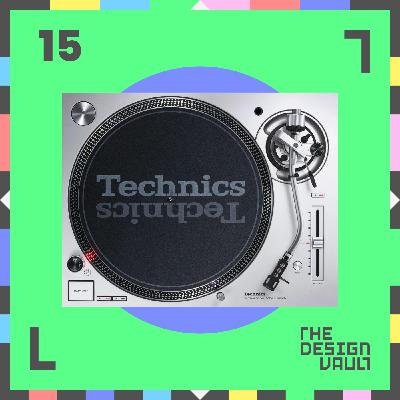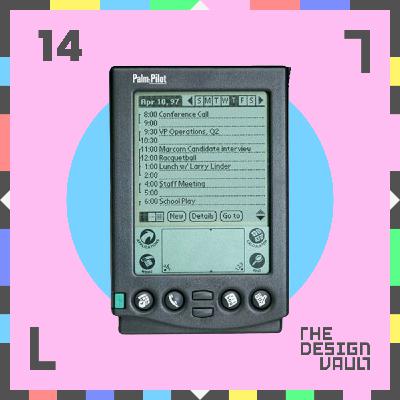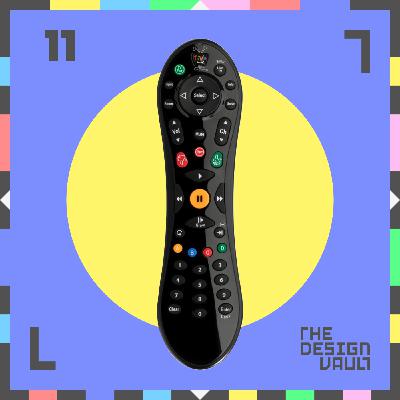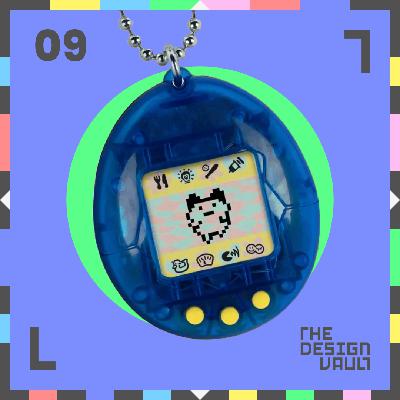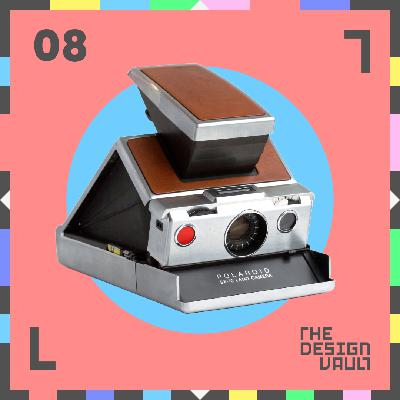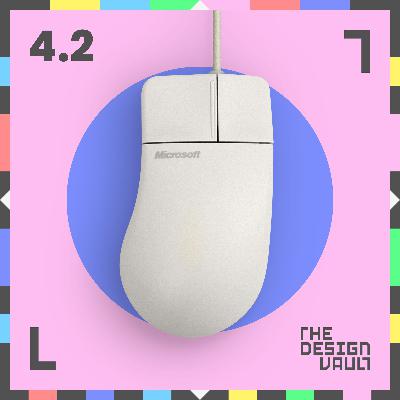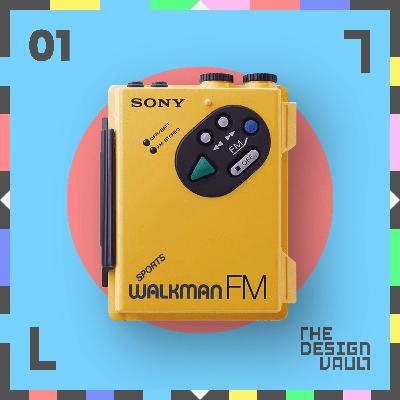Discover The Design Vault
The Design Vault

The Design Vault
Author: The Design Vault
Subscribed: 4Played: 12Subscribe
Share
Copyright © 2024-2025 The Design Vault, LLC. All Rights Reserved.
Description
A show about the past, present, and future of design. The Design Vault is a conversation hosted by Albert Shum and Thamer Abanami, reflecting on iconic products and ideas from the past, and rethinking them from new perspectives.
FOLLOW US
@thedesignvaultpodcast on Instagram
Hosts: Albert Shum and Thamer Abanami
Editor: Rachel James
Intro Music: Red Lips Media LLC
Brand Design: Rafael Poloni
20 Episodes
Reverse
Episode Overview
In this episode of The Design Vault, hosts Albert Shum and Thamer Abanami are joined by legendary producer Dan the Automator Nakamura (Gorillaz, Deltron 3030, Dr. Octagon) to explore the Technics SL-1200 MK2 — the direct drive DJ turntable that evolved from an audiophile product into a central instrument for hip hop, house, and techno DJs and producers.
From Konosuke Matsushita’s long-term “250-year philosophy” to Grand Wizard Theodore’s scratching breakthrough, this is the story of how Japanese engineering precision met street creativity to create one of the most influential musical instruments of the late 20th century. Dan shares personal stories of witnessing a young Qbert and Mix Master Mike before fame, why the 1200 is often called the “Porsche 911 of turntables,” and how the constraints of early sampling technology shaped hip hop’s signature sound.
Episode Length: 1:01:59
Original Air Date: September 23, 2025
Hosts: Albert Shum, Thamer Abanami
Special Guest: Dan the Automator Nakamura
Key Segments & Timestamps
Sound Recording’s Strange Beginning (00:02:25 - 00:07:44)
1857: First sound recorded but unplayable for 151 years
Edison’s phonograph and “Mary Had a Little Lamb”
Emile Berliner’s flat disc revolution and the birth of the record industry
The LP vs. 45 RPM rivalry that settled into coexistence
How physical media constraints shaped modern music
Matsushita’s Long-Term Philosophy (00:07:44 - 00:13:11)
23-year-old Konosuke Matsushita starts with 100 yen
The “tap water philosophy”: abundance through affordability
From handmade plugs to bicycle lamps that lasted 40 hours
Post-WWII Japan’s “three sacred treasures”
How long-term thinking created Panasonic and its Technics brand
The Direct Drive Revolution (00:13:11 - 00:18:03)
Belt drive’s fatal flaw: wow and flutter
Shuichi Obata eliminates the rubber band middleman
The SP-10: world’s first direct drive for broadcasting
Why torque and instant startup changed everything
From FM radio booths to consumer turntables
Birth of the 1200 Legacy (00:18:03 - 00:24:31)
1972: SL-1200 MK1 launches for home audiophiles
DJs discover unintended benefits: rock-solid speed, durability
Kool Herc’s “merry-go-round” technique extends breaks
Engineers began to notice how DJs in emerging club and hip hop scenes were pushing the decks in new ways
1979: The MK2 arrives with DJ-specific features
The Accidental Art of Scratching (00:26:21 - 00:32:10)
Grand Wizard Theodore’s mother interrupts practice
From holding a record in place to creating percussion
Grandmaster Flash perfects “quick mix theory”
Herbie Hancock’s Rockit brings scratching to MTV
Regional styles emerge: Philadelphia smooth vs. West Coast technical
Dan’s Evolution of Scratch Styles (00:32:10 - 00:34:07)
Jam Master Jay’s percussive power approach
Philadelphia’s transform scratch innovation
West Coast technical precision with Mix Master Mike
DJ Premier’s loose, funky internal metronome
How each region developed distinct aesthetics
Design Analysis: Japanese Precision Meets Street Culture (00:36:47 - 00:42:14)
24 pounds of die-cast aluminum confidence
5-pound platter with machined strobe dots
Pop-up target light for dark club cueing
Brushed metal buttons built to survive anything
Typography that defined an era of Japanese electronics
The Digital Transformation (00:47:03 - 00:54:10)
From vinyl crates to CD wallets: Pioneer’s CDJ
Serato’s time-coded vinyl preserves feel, adds infinite music
Digital controllers merge software with tactile control
2010: Technics stops production after 38 years
2016 revival, with 2019 models reborn as $1,000+ luxury nostalgia products
Technology as Creative Catalyst (00:56:18 - 00:59:01)
How technical limitations create aesthetic signatures
Photography’s threat becoming opportunity
Electronic music’s journey to legitimacy
Why constraints breed genres
AI and the next creative frontier
Credits
Hosts: Albert Shum and Thamer Abanami
Special Guest: Dan the Automator Nakamura
Editor: Rachel James
Intro Music: Red Lips Media
Brand Design: Rafael Poloni
Connect With The Design Vault on Instagram @thedesignvaultpodcast
Episode Overview
In this episode of The Design Vault, hosts Albert Shum and Thamer Abanami explore the remarkable story of the PalmPilot—the device that solved the PDA puzzle through radical constraint. When Jeff Hawkins carved a block of wood into the shape of a shirt-pocket computer and carried it everywhere, pretending to use it throughout his day, he wasn't just prototyping a product—he was designing the first truly successful bridge between desktop and mobile computing.
From its 1996 launch to its $53 billion peak valuation to its eventual absorption into smartphones, the PalmPilot's journey reveals timeless lessons about simplicity versus complexity, the power of ecosystem thinking, and why being first doesn't guarantee survival. This episode uncovers how three taps, 160x160 pixels, and a simplified alphabet called Graffiti almost gave us the smartphone era five years early.
Episode Length: 39:21
Original Air Date: September 9, 2025
Hosts: Albert Shum, Thamer Abanami
Key Segments & Timestamps
Setting the Stage: The Gadget Graveyard (00:00:20 - 00:04:35)
The 1990s digital device explosion: Casio organizers, Sharp Wizards, and others
Apple Newton's $700 failure and handwriting recognition jokes
The junk drawer problem: expensive solutions looking for problems
Enter Jeff Hawkins: The Wooden Computer (00:04:43 - 00:08:04)
Hawkins' background: electrical engineering, neuroscience, and Grid Systems
Palm Computing's founding in 1992 with Donna Dubinsky and Ed Colligan
The wooden prototype: carrying a carved block of wood for months
Pretotyping in practice: fake meetings with a fake device
Design Philosophy: The Zen of Palm (00:08:04 - 00:14:31)
Form factor constraints: 4.7" x 3.2" x 0.7", under 6 ounces
160x160 monochrome display as design driver
Graffiti: making humans adapt to the machine (97% accuracy)
The three-tap rule and Rob Haitani's tap counter
Instant-on philosophy: no boot time, no waiting
The HotSync Revolution (00:14:31 - 00:21:42)
Creating the first seamless desktop-to-mobile bridge
Conflict resolution algorithms for two-way synchronization
Email on the go: the killer app emerges
Building the third-party app ecosystem
Market Triumph: Fastest Growing Computer Product (00:24:04 - 00:28:26)
Launch reception: 1 million units in 18 months
The magic $299 price point
70% market share by 2000
Healthcare, sales teams, and executive adoption
Corporate Turbulence and Competition (00:25:27 - 00:33:17)
Microsoft's Windows CE entry and desktop replication strategy
The Handspring betrayal: founders becoming competitors
BlackBerry's wireless disruption and enterprise email dominance
Palm's split into hardware and software divisions
WebOS development: the moonshot that came too late
The iPhone Moment and Legacy (00:32:27 - 00:39:21)
2007: The disruption nobody could adapt to
Palm's $53 billion peak valuation during the dot-com bubble
HP's acquisition and the LG TV connection
Timeless lessons: constraint-driven innovation and simplicity
Why "almost right" in tech often means complete failure
Connect With The Design Vault
The Design Vault explores iconic products from the innovation-rich 1970s-early 2000s, extracting strategic insights for today's designers, engineers, and business leaders. Each episode combines nostalgic storytelling with actionable lessons for modern product development.
Subscribe: Available on all major podcast platforms including Spotify, Apple, and more
Follow us: Instagram: @thedesignvaultpodcast, LinkedIn: Thamer Abanami, Albert Shum
We'd love to hear your thoughts, episode ideas and feedback via the links above.
Credits
Hosts: Albert Shum and Thamer Abanami
Editor: Rachel James
Intro Music: Red Lips Media
Brand Design: Rafael Poloni
Episode Overview
In this episode of The Design Vault, hosts Albert Shum and Thamer Abanami explore the extraordinary story of the Citroën DS, arguably the most audacious automobile ever created. Born from the devastation of post-WWII France, this revolutionary car emerged from an 18-year development odyssey that challenged every automotive convention. With insights from retired Apple and Motorola design leader Tim Parsey, who owned multiple DS models, this episode reveals how a dream team of engineers and designers created a vehicle so advanced it seemed to come from the future. From its magical hydropneumatic suspension to its aerodynamic sculpture-on-wheels aesthetic, the DS completely reimagined what a car could be.
Original Air Date: August 26, 2025
Episode Length: 38:31
Hosts: Albert Shum, Thamer Abanami
Guest: Tim Parsey (Former Apple, Motorola, Mattel Design Leader)
Key Segments & Timestamps
The Context: Post-War France’s Design Challenge (00:20 - 03:58)
Post-WWII devastation creating space for radical innovation
Rough roads, high fuel taxes, and the culture of efficiency
Charles de Gaulle’s “grandeur” vision driving technological ambition
How constraints became catalysts for breakthrough thinking
The Automotive Landscape: A World Ripe for Disruption (03:58 - 06:10)
American excess era: 42-inch tail fins and chrome measured by weight
Germany’s people’s car philosophy with the Beetle
Britain maintaining pre-war conservatism
France’s strategy to leapfrog rather than catch up
Citroën’s Culture of Radical Innovation (06:10 - 08:45)
André Citroën’s front-wheel-drive gamble with the Traction Avant
The critical 1934 bankruptcy and Michelin’s revolutionary takeover
Pierre Boulanger’s radical decision: “Keep engineers, fire accountants”
The 2CV’s parallel development funding DS ambitions
The Dream Team (08:45 - 11:50)
André Lefebvre: Aeronautical engineer with a backlog of innovations
Paul Magès: Self-taught genius behind hydropneumatic suspension
Flaminio Bertoni: Italian sculptor turned automotive stylist
Why letting creative minds loose is “highly risky but necessary”
The 18-Year Development Odyssey (11:50 - 16:21)
Simple question: Why improve roads when you can improve cars?
Secret development during WWII
The hydropneumatic breakthrough: Gas compresses, liquid transmits
Systems integration: One technology powering suspension, brakes, steering
40% of build cost invested in hydraulic complexity
The Theatrical Launch: Paris 1955 (17:16 - 20:03)
Grand Palais transformed into theater
The silk sheet drops, crowds gasp
12,000 pre orders—a record until Tesla Model 3
The strategic 500-customer beta program with dedicated engineers
Living with Revolutionary Complexity (20:03 - 23:05)
The infamous “mushroom brake” and its quirks
Tim’s near-death experience
“Marking territory with hydraulic fluid”
Why the experience had to be driven to be understood
The Meditative Magic: What Made DS Special (23:05 - 27:03)
“Like gliding around… a meditative experience”
Magic carpet ride over speed bumps
Why no other manufacturers copied the formula
Engineering complexity as competitive moat
Evolution and Variants (27:03 - 28:55)
From “frog eyes” to swiveling directional headlights (1967)
Power progression: DS 19, DS 21, DS 23
Safari wagons, Pallas luxury, SM with Maserati power
“Frogs have personality. Fairings don’t.”
Design Philosophy: Engineering as Art (28:55 - 32:39)
Perfect tension between engineering and sculptural beauty
Authentic aerodynamics vs. American “rocket ship” styling
Three-dimensional airflow management with under-car panels
Flush door handles decades before Tesla
Interior as Living Room (32:39 - 35:20)
Four interior lights creating ambient atmosphere
Bench seats and column-mounted gear shifter maximizing space
Single-spoke steering wheel for unobstructed view
Dashboard-mounted mirror at natural eye level
Personal Connection: Tim’s First DS Story (35:20 - 38:27)
£30 for two broken cars to make one working DS
Brilliant engineering: body panels removable with single bolts
Digging holes in frozen ground to replace hydraulic lines
The devotion that revolutionary design inspires
Legacy and Lessons for Modern Innovators (38:27 - 38:31)
Showing possibilities people never imagined
The courage to exist “outside of time”
Why serving people sometimes means ignoring market research
Dream teams without financial constraints
Connect With The Design Vault
The Design Vault explores iconic products from the innovation-rich 1970s-early 2000s, extracting strategic insights for today’s designers, engineers, and business leaders. Each episode combines nostalgic storytelling with actionable lessons for modern product development.
Subscribe: Available on all major podcast platforms including Spotify, Apple, and more
Follow us: Instagram: @thedesignvaultpodcast, LinkedIn: Thamer Abanami, Albert Shum
We’d love to hear your thoughts, episode ideas and feedback via the links above.
Credits
Hosts: Albert Shum and Thamer Abanami
Guest: Tim Parsey
Editor: Rachel James
Intro Music: Red Lips Media LLC
Brand Design: Rafael Poloni
Episode Overview
In this episode of The Design Vault, hosts Albert Shum and Thamer Abanami explore the remarkable story of the Koss Porta Pro, a pair of headphones that defied every rule of consumer electronics and emerged as an unlikely icon. Launched in 1984 at $49.95, these skeletal-looking headphones still sell for the exact same price today, effectively making them much cheaper due to inflation. From John Koss's accidental entry into electronics to a bankruptcy-driven product that became permanent, the Porta Pro story shows how understanding human needs—not industry assumptions—creates timeless design. This episode uncovers why a product initially rejected by some for looking "too cheap" became a cult object spanning from veteran audiophiles to Gen Z walkman enthusiasts, and how its "evergreen product strategy" challenges everything we believe about planned obsolescence.
Episode Length: 37:02
Original Air Date: August 12, 2025
Hosts: Albert Shum, Thamer Abanami
Key Segments & Timestamps
Why This Matters Now (00:02:54 - 00:04:06)
The concept of "accessible excellence" in consumer electronics
Democratizing high-quality audio like IKEA democratized design
The lifetime warranty as a design constraint
Predicting the "good enough" revolution in consumer tech
Setting the 1984 Scene (00:04:06 - 00:05:55)
Sony Walkman's five-year dominance with "awful" bundled headphones
The portability penalty: accepted wisdom that portable meant compromised
Uncomfortable foam speakers vs. expensive home-use models
Music becoming private and mobile: the cultural shift
The gap in the marketplace nobody was addressing
John Koss: The Accidental Revolutionary (00:05:55 - 00:08:15)
Jazz musician turned TV rental entrepreneur (1953)
Creating the first stereo headphones (SP/3) in 1958
Philosophy: "Music should be accessible to everyone"
Chapter 11 bankruptcy in 1984: crisis as catalyst
Project "Light and Lively": the two-year development journey
The Design Brief That Changed Everything (00:09:10 - 00:10:42)
Under $50 retail target (radical for quality audio)
Must work with low-powered portable devices
Titanium-coated Mylar drivers innovation
"For those with a refined ear for music"
Research findings: pressure, heat, weight, and "hair disruption"
Physical Design: Anti-Fashion as Philosophy (00:10:56 - 00:14:56)
The skeletal wire sculpture aesthetic
Completely exposed architecture: structure as aesthetic
Collapsible design that becomes its own case
The Comfort Zone System: temple and ear pressure distribution
Minimal branding in the age of logos
Pop colors against '80s neon excess
Technical Innovation: The Sound of Revolution (00:15:05 - 00:19:40)
30mm dynamic drivers with 15-25,000 Hz response
Open-back design creating spacious soundstage
Tuned for satisfaction, not accuracy
The secret language of audio: warm vs. bright vs. flat
Why titanium-coated Mylar matters
Optimized for battery-powered Walkmans
Confident Evolution (00:19:55 - 00:22:55)
1984: Launch at $60, quickly drops to $49.95
1991: Michael J. Koss takes over, maintains vision
1995: KSC clip-on variants using same drivers
1999: Sporta Pro for active users
2009: 25th anniversary with commemorative coin
2016: New colorways prove aesthetics still matter
2018: Bluetooth version (80% sound quality trade-off)
2021: Utility model with detachable cables
2024: Giant billboard in Milwaukee celebrating current product
The Lifetime Warranty Gamble (00:22:55 - 00:24:48)
No-questions-asked lifetime warranty on $50 product
Small company competing with Sony and Panasonic
Creating trust through radical commitment
The evergreen product strategy: no planned obsolescence
Replacement parts always available
Sustainable business through consistency
Price as Philosophy (00:24:48 - 00:27:37)
Maintaining $49.95 for four decades
Arizona Iced Tea pricing strategy parallel
Destroying the premium price equals quality assumption
66% cheaper today accounting for inflation
Manufacturing efficiency through unchanging design
The rise of low-priced, high-quality audio segment
Cultural Impact: From Anti-Design to Icon (00:27:37 - 00:30:21)
The Porta Pro cult: forums and modifications
Cable mods, Yaxi pads, 3D printed parts
People spending more on mods than the headphones cost
Producers and musicians adopting them
Design blogs rediscovering "anti-fashion headphones"
Gen Z discovery through TikTok and Retrospekt
The Evergreen Product Strategy (00:31:02 - 00:32:45)
No annual updates, no Mark II planned
75% family ownership enabling long-term vision
Growth vs. consistency mindset
Minor necessary revisions only
Same product for 40 years
Word-of-mouth over marketing spend
Design Legacy: Honesty as Movement (00:32:54 - 00:35:22)
Transparent aesthetic and exposed architecture
Influence on Teenage Engineering and Nothing
Comfort-first design approach adoption
Temple relief concept in gaming headsets
Ultra-lightweight construction principles
Wearable computing implications
More than human factors and ergonomics
Ultimate Lessons (00:35:31 - 00:37:02)
Consistency as the most radical act
Permanence as revolution in obsolescence-driven market
Excellence can be democratic
Understanding people vs. industry assumptions
The masterclass in design philosophy
Sustainability through timelessness
Connect With The Design Vault
The Design Vault explores iconic products from the innovation-rich 1970s-early 2000s, extracting strategic insights for today's designers, engineers, and business leaders. Each episode combines nostalgic storytelling with actionable lessons for modern product development.
Subscribe: Available on all major podcast platforms including Spotify, Apple, and more
Follow us: Instagram: @thedesignvaultpodcast, LinkedIn: Thamer Abanami, Albert Shum
We'd love to hear your thoughts, episode ideas and feedback via the links above.
Credits
Hosts: Albert Shum and Thamer Abanami
Editor: Rachel James
Intro Music: Red Lips Media LLC
Brand Design: Rafael Poloni
Episode Overview
In this episode of The Design Vault, hosts Albert Shum and Thamer Abanami explore the revolutionary TiVo digital video recorder, a product so transformative it became a verb, yet ultimately couldn't capitalize on the future it created. From the moment TiVo demonstrated pausing live TV at CES 1999, leaving journalists bewildered by this "magic trick," to its eventual relegation as a feature in cable boxes, TiVo's story exemplifies the classic innovator's dilemma. This episode reveals how two Silicon Graphics engineers created the first truly intuitive TV interface, pioneered recommendation algorithms, and invented binge-watching culture, only to watch cable companies commoditize their revolution with inferior but "barely good enough" alternatives.
Episode Length: 46:19
Original Air Date: July 29, 2025
Hosts: Albert Shum, Thamer Abanami
Key Segments & Timestamps
The Pre-TiVo Dark Ages (00:04:27 - 00:06:41)
The tyranny of appointment television and TV Guide magazines
VCRs: The engineering nightmare requiring "post-doc degree" to program
Missing shows meant waiting for syndication reruns
The anti-design philosophy of consumer electronics
Pattern of Japanese hardware companies struggling with software integration
The perfect storm for disruption in an entrenched industry
The Unlikely Revolutionaries (00:07:49 - 00:10:14)
Mike Ramsey and Jim Barton: Engineers at Silicon Graphics
Both laid off on the same day in 1997
Ramsey's Nintendo 64 architecture background
Barton's radical philosophy: "Technology should be invisible"
Original company name: Teleworld
Initial vision: Home network computer for email, web, and TV
The crucial pivot to focus solely on "fixing TV"
The Technical Breakthroughs (00:10:14 - 00:14:45)
Time-shifting vs. time-traveling: Making the impossible possible
Hard drives in consumer devices: Revolutionary for 1998
Real-time MPEG-2 compression on the fly
The genius of the phone line connection for guide data
14-day program guide with full metadata
Linux-based system hidden behind appliance simplicity
Constant recording buffer: The secret to pausing live TV
The Peanut Remote Revolution (00:16:16 - 00:21:09)
Collaboration with IDEO for ergonomic design
Kidney-shaped form factor for natural hand fit
Rubberized texture and balanced weight distribution
Giant play/pause button as centerpiece
Revolutionary thumbs up/thumbs down buttons
Color-coded interface with playful audio cues
Progressive disclosure: Hiding complexity behind simplicity
Five-minute learning curve vs. VCR manuals
The Recommendation Engine Pioneer (00:25:12 - 00:27:05)
First consumer product with predictive algorithms
Thumbs up/down creating personalized profiles
Anonymous data aggregation across users
Filling empty drive space with predicted content
The birth of algorithmic content curation
Foreshadowing modern streaming recommendations
Behavioral Revolution: The End of Appointment TV (00:28:24 - 00:30:42)
Liberation from network scheduling tyranny
Birth of binge-watching culture
Season Pass: Automating series recording
The unintended consequences of time control
Changing social dynamics around TV viewing
From shared cultural moments to personalized experiences
The Commercial Skip Controversy (00:30:42 - 00:33:15)
Fast-forward through commercials: Industry panic
Replay TV's automatic commercial skip and lawsuit
TiVo's careful balance: Manual skip only
Time Warner's advertising boycott
Patent wars with EchoStar and Dish Network
$500 million settlement vindication
The beginning of the licensing company pivot
The Platform Squeeze (00:33:23 - 00:38:11)
Cable companies as both partners and competitors
The bundling advantage: "Free" DVR with cable box
Distribution trumps design quality
Good enough beats better when it's bundled
The frenemy relationship trap
Why paying extra for TiVo became a hard sell
Loyal users vs. mass market adoption
The Innovator's Dilemma Crystallized (00:36:04 - 00:39:17)
TiVo as the purest example of Christensen's theory
Educating the market for competitors to harvest
Fighting legal battles that benefited everyone
Establishing UI conventions copied industry-wide
Premium features few would pay extra for
The brutal reality of seeing it coming but being powerless
Modern Parallels and Lasting Impact (00:41:59 - 00:45:56)
Netflix, YouTube TV, Hulu: All running TiVo's playbook
The DNA in every streaming interface today
Design matters more than technology specs
Business model innovation as crucial as product innovation
Platform dynamics in content industries
The Peloton parallel: Great product, platform challenges
Why being revolutionary isn't always enough
Connect With The Design Vault
The Design Vault explores iconic products from the innovation-rich 1970s-early 2000s, extracting strategic insights for today's designers, engineers, and business leaders. Each episode combines nostalgic storytelling with actionable lessons for modern product development.
Subscribe: Available on all major podcast platforms including Spotify, Apple, and more
Follow us: Instagram: @thedesignvaultpodcast, LinkedIn: Thamer Abanami, Albert Shum
We'd love to hear your thoughts, episode ideas and feedback via the links above.
Credits
Hosts: Albert Shum and Thamer Abanami
Editor: Rachel James
Intro Music: Red Lips Media LLC
Brand Design: Rafael Poloni
Episode Overview
In this episode of The Design Vault, hosts Albert Shum and Thamer Abanami explore the remarkable story of the Casio G-Shock DW5000C—a watch born from heartbreak that revolutionized an entire industry. When engineer Kikuo Ibe's cherished graduation gift from his father shattered on the floor in 1981, it sparked a two-year obsession to create the "unbreakable watch." What emerged wasn't just a timepiece, but an entirely new design language of durability that would influence everything from smartphones to extreme sports culture. This episode reveals how three engineers, armed with the "Triple 10" challenge and radical thinking, transformed failure into one of the most iconic products of the 1980s.
Episode Length: 31:35
Original Air Date: July 1, 2025
Hosts: Albert Shum, Thamer Abanami
Key Segments & Timestamps
Casio's Unexpected Origins (00:01:18 - 00:03:27)
Post-WWII Japan
The unlikely first product
Trading company crisis and strategic pivot
Japan's first all-electric compact calculator
The Quartz Revolution Context (00:03:31 - 00:05:00)
The "quartz crisis" that upended Swiss watchmaking
How quartz makes watches accurate
Japanese engineering vs. traditional watch craftsmanship
How disruption created space for radical innovation
The Broken Watch Catalyst (00:05:39 - 00:06:29)
A father's gift becomes an engineer's obsession
Why an outsider perspective mattered
Casio's green light for the "unbreakable watch"
Team Tough Formation (00:06:46 - 00:07:56)
Three engineers working in isolation
Breaking Japanese corporate conventions
The "Triple 10" concept: An impossible challenge
Science fiction requirements for 1981 technology
Design Iteration Journey (00:08:30 - 00:11:12)
Construction workers who couldn't wear watches
Rubber balls, duct tape, and softball-sized failures
Third-floor bathroom window experiments
A year on the "treadmill" of failure
The Sunday in the Park Eureka (00:12:18 - 00:14:17)
Ibe's self-imposed ultimatum: One week or resignation
Children playing in a park spark breakthrough
The "floating module" revelation
Why internal beats external protection
Design Language of Durability (00:14:39 - 00:19:13)
Breaking every conventional watch design rule
"Designed for a future that never happened"
Brutalist aesthetics meet mathematical precision
How exterior design signals interior innovation
Cultural Context & Market Reception (00:19:13 - 00:21:51)
Extreme sports explosion meets watch design
Japanese market rejection: "Too unconventional"
The hockey puck commercial that changed everything
Controversy becomes marketing gold
Unexpected Cultural Adoption (00:21:56 - 00:23:20)
From NASA to fashion
Professional tool becomes streetwear icon
Casio's pivot to embrace the unexpected
When performance credibility drives fashion
Business Impact & Design Legacy (00:23:20 - 00:26:02)
Creating a new category in a saturated market
From G-Shock to smartphones: The durability revolution
How one watch influenced the idea of “rugged” design
Durability as primary feature, not afterthought
Key Design Lessons (00:26:22 - 00:32:17)
Personal setbacks driving professional breakthroughs
The power of direct observation over data reports
Small teams, big impacts: Agility outside the machine
Design for one, adopted by many
Why home market failure doesn't doom global success
The art of positioning and storytelling
Connect With The Design Vault
The Design Vault explores iconic products from the innovation-rich 1970s-early 2000s, extracting strategic insights for today's designers, engineers, and business leaders. Each episode combines nostalgic storytelling with actionable lessons for modern product development.
Subscribe: Available on all major podcast platforms including Spotify, Apple, and more
Follow us: Instagram: @thedesignvaultpodcast, LinkedIn: Thamer Abanami, Albert Shum
We’d love to hear your thoughts, episode ideas and feedback via the links above.
Credits
Hosts: Albert Shum and Thamer Abanami
Editor: Rachel James
Intro Music: Red Lips Media LLC
Brand Design: Rafael Poloni
Episode Overview
In this episode of The Design Vault, hosts Albert Shum and Thamer Abanami explore the remarkable story of the Bandai Tamagotchi—a simple plastic egg with three buttons that revolutionized our relationship with technology. Born from Japan's economic "lost decade" and the rise of kawaii culture, this virtual pet created an entirely new paradigm for emotional engagement with digital devices. From Akihiro Yokoi's inspiration watching a boy unable to take his pet turtle on vacation, to the collaboration between toy company Bandai and design firm Wiz, the Tamagotchi pioneered concepts that would later define social media, mobile gaming, and AI companions. This episode reveals how a 32x16 pixel screen taught millions about digital responsibility while establishing the psychological phenomenon known as the "Tamagotchi effect."
Episode Length: 31:36
Original Air Date: July 1, 2025
Hosts: Albert Shum, Thamer Abanami
Key Segments & Timestamps
The Perfect Storm: Japan in the 1990s (00:02:03 - 00:04:57)
Economic "lost decade" following the bubble burst
Imperial Palace valued more than California real estate
Traditional consumer spending decline driving affordable luxury demand
Rise of kawaii culture and character-driven design
Gap in the market between expensive Game Boys and simple entertainment
Cultural shift from pure utility to emotional design
The Players: Bandai and Wiz Partnership (00:04:57 - 00:07:40)
Bandai's 1950 founding as toy and hobby company built on licensed character merchandise
Wiz as small independent toy design company led by Akihiro Yokoi
New York Toy Fair dynamics and independent inventor ecosystem
Albert's experience with Yakbak toy and Worlds of Wonder
Collaboration model between toy companies and design firms
The Inspiration: From Pet Turtle to Virtual Pet (00:07:40 - 00:09:20)
TV commercial showing boy unable to take pet turtle on vacation
Yokoi's vision: pets without cleanup, expense, or traditional constraints
Original watch-based concept combining "tamago" (egg) and "ouchi" (watch)
User testing preference for separate keychain device over wristwatch
Extreme focus on simplicity driven by cost constraints and portability needs
Gameplay Mechanics: Digital Responsibility (00:09:20 - 00:11:11)
Evolution-based gameplay responding to player care and engagement
Battery tab activation creating "no pause" always-on experience
Feed, clean, discipline, and play interactions with visible stats
Character evolution from simple forms to unknown outcomes based on care quality
Japanese vs. US version differences: death vs. "returning to home planet"
Physical Design: The Egg That Changed Everything (00:11:23 - 00:15:56)
Cookie-sized plastic egg in pastel colors (baby blues, soft pinks, gentle yellows)
Postage stamp-sized LCD screen creating "window to another world"
Three circular buttons in triangular pattern below screen
Keychain attachment as fashion accessory and personal expression
Cracked egg aesthetic revealing the digital world within
Tactile button engagement and fidget factor importance
Digital Design: Maximum Expression from Minimum Pixels (00:16:06 - 00:19:54)
Character design: Emotional expression through kawaii aesthetics
32x16 pixel constraint: Screen only 1.2" wide by 1.5" tall
Sound design: Piezo speaker creating urgency and emotional connection through frequency modulation
Interface hierarchy: Main screen with top row caring icons and bottom row status indicators
Top row functions: Fork/knife (feeding), ball/bat (playing), light bulb (sleep), syringe (medicine)
Bottom row status: Happy/sad faces, cleanliness indicators, health meters, sound controls
Technical Innovation: Constraints as Advantages (00:19:54 - 00:21:39)
Lifecycle simulation and personality development algorithms
Random event generation following B.F. Skinner's variable reward research
Complex technical sophistication hidden behind simple three-button interface
No manual, setup routine, or EULA required
Display cost constraints driving creative interface solutions
Cultural Impact: The Tamagotchi Effect (00:21:54 - 00:23:42)
Pioneering emotional attachment to digital devices
Preview of current technology relationships and smartphone behaviors
Creation of new social behaviors around technology
Influence on parent-child dynamics with devices
Global phenomenon crossing age and gender boundaries
Technology personification and relationship development patterns
Technological Legacy: Always-On Digital Worlds (00:23:47 - 00:25:38)
Persistent world concept with continuous gameplay loops
Service-based interaction model requiring ongoing engagement
Downloadable content precursor through feeding and care requirements
Connection to modern social media engagement patterns
Foundation for current "always-on" digital experiences
Business Transformation: Character-Driven Products (00:24:53 - 00:26:18)
Establishment of virtual pet product category
Demonstration of emotional connection value in technology
Cross-promotion and special edition marketing strategies
Character extension into both virtual and physical product ecosystems
Cross-cultural product design success from Japan to United States
Gamification Blueprint: The Engagement Playbook (00:26:18 - 00:29:46)
Core mechanics: Regular check-ins, care-based rewards, progressive difficulty
Achievement-based evolution and social proof elements
Connection to modern apps like Foursquare and social media platforms
Digital addiction patterns and FOMO (fear of missing out) creation
Dopamine hit trigger-reward loops in social media engagement
AI companion relationships and emotional attachment concerns
Ethics of emotional engagement vs. emotional manipulation
Modern Relevance: Lessons for AI Design (00:29:01 - 00:31:36)
Enduring design principles: simplicity, constraint, and emotional connection
Balance between technical sophistication and intuitive interfaces
Understanding intended and unintended consequences of emotional engagement
Control mechanisms and user agency in AI relationships
Implications for agentic AI development and human-AI interaction design
Connect With The Design Vault
The Design Vault explores iconic products from the innovation-rich 1970s-early 2000s, extracting strategic insights for today's designers, engineers, and business leaders. Each episode combines nostalgic storytelling with actionable lessons for modern product development.
Subscribe: Available on all major podcast platforms including Spotify, Apple, and more
Follow us: Instagram: @thedesignvaultpodcast, LinkedIn: Thamer Abanami, Albert Shum
We'd love to hear your thoughts, episode ideas and feedback via the links above.
Credits
Hosts: Albert Shum and Thamer Abanami
Editor: Rachel James
Intro Music: Red Lips Media LLC
Brand Design: Rafael Poloni
Episode Overview
In this episode of The Design Vault, hosts Albert Shum and Thamer Abanami explore the revolutionary Polaroid SX-70 camera—a masterpiece of industrial design that transformed photography from a technical craft into an emotional, shared experience. From a child's innocent question in 1943 to a groundbreaking product that required 30 years of development, the SX-70 represents one of the most ambitious engineering achievements of the 1970s.
Episode Length: 46:23
Original Air Date: July 17, 2025
Hosts: Albert Shum, Thamer Abanami
Key Segments & Timestamps
The Genesis Story (00:00:53 - 00:07:04)
The evolution of photography from 1840s collotype processes to 1970s instant cameras
Edwin Land's background: Harvard dropout turned optical genius
The pivotal 1943 moment: "Why can't I see the picture now?"
Polaroid's wartime contributions and early instant photography experiments
The 30-Year Journey (00:07:04 - 00:10:46)
From the 1948 Model 95's "peel-apart" process to the SX-70's seamless integration
Land's vision of true "one-step photography"
The convergence of multiple breakthrough technologies
Engineering Marvel Breakdown (00:10:46 - 00:14:00)
17-layer film chemistry: Each layer precisely timed for daylight development
Folding SLR design: Over 200 parts collapsing to 1-inch thickness
Integrated power system: Flat battery in every film pack
Manufacturing innovations: Custom machinery for multi-layer optical assemblies
Human-Centered Design Philosophy (00:14:00 - 00:16:25)
Henry Dreyfus's ergonomic principles applied to camera design
Two-state transformation: closed leather rectangle to precision instrument
Minimalist control philosophy: one red button operation
Premium materials and tactile experience considerations
The Chemistry of Magic (00:18:52 - 00:21:13)
How 17 chemical layers create instant development
Temperature sensitivity engineering (65-85°F optimal range)
Opacity layers preventing light contamination
Steel roller precision: spreading chemicals to 1/1000th inch thickness
Aesthetic Revolution (00:21:50 - 00:28:39)
The distinctive Polaroid "look": dreamy color palette and soft contrast
Iconic white frame: constraint transformed into feature
Semi-gloss finish and three-dimensional image quality
Artist adoption and manipulation techniques (Lucas Samaras photo transformations)
Marketing Genius & Cultural Impact (00:28:49 - 00:33:52)
Premium positioning strategy: $180 launch price (≈$1,200 today)
Influencer strategy with Andy Warhol, David Hockney, Ansel Adams
Land's theatrical product launches (10,000 imported tulips for color demo)
Democratization through OneStep camera: $180 to $40 in five years
The Kodak Wars (00:33:52 - 00:38:26)
Partnership to rivalry: from supplier relationship to patent warfare
Kodak's 1976 instant camera launch and subsequent lawsuit
$909 million settlement in Polaroid's favor (1990)
Leadership changes and strategic miscalculations
Digital Disruption & Decline (00:38:26 - 00:42:13)
Both companies pioneering early digital camera technology
Chemical engineering DNA preventing digital pivot
Polaroid bankruptcy (2001), Kodak bankruptcy (2012)
The innovator's dilemma in action
Further Reading & Resources
A Triumph of Genius, - Inside account of Polaroid vs. Kodak patent battle
Peter Gabriel's "Melt" album cover (photo manipulation technique)
Lucas Samaras photo transformation artworks
Analog Resurgence: Ultimate SX-70 Guide
Connect With The Design Vault
The Design Vault explores iconic products from the innovation-rich 1970s-early 2000s, extracting strategic insights for today's designers, engineers, and business leaders. Each episode combines nostalgic storytelling with actionable lessons for modern product development.
Subscribe: Available on all major podcast platforms including Spotify, Apple, and more
Follow us: Instagram: @thedesignvaultpodcast, LinkedIn: Thamer Abanami, Albert Shum
We’d love to hear your thoughts, episode ideas and feedback via the links above.
Credits
Hosts: Albert Shum and Thamer Abanami
Editor: Rachel James
Intro Music: Red Lips Media LLC
Brand Design: Rafael Poloni
Thank you to all our listeners for your incredible support throughout Season 1! Your feedback and engagement have helped us learn, grow, and adapt, and we can’t wait to continue this journey with you.
Season 2 is just around the corner, launching in Spring 2025! We’re excited to bring you even more stories about iconic products and their impact on design, business, technology, and culture.
In Season 2, we’ll dive deep into a wide range of topics, including the fascinating story behind the original Casio G-Shock, the world of Tamagotchi, the innovation that made the Polaroid Camera a cultural icon, and a closer look at the Technics SL-1200 turntable and its influence on music and culture—along with many more iconic designs that have shaped our world.
Stay tuned for another season packed with captivating stories, unexpected insights, and inspiring designs.
Thank you again for being a part of this journey. We look forward to seeing you for Season 2 Spring 2025!
Join us as we shape the future of design by learning from the past.
FOLLOW US
Instagram
Albert's LinkedIn
Thamer's LinkedIn
Hosts: Albert Shum and Thamer Abanami
Production and Post-production: Romina Hakim, Toño Tellez and Poonam Patel
Music: Red Lips Media LLC
Brand Design: Rafael Poloni
Welcome back to another episode of The Design Vault with your hosts Albert Shum and Thamer Abanami. Today we explore an absolute game changer in the world of music technology—the Roland TR-808 drum machine.
Despite its initial commercial failure, the TR-808 revolutionized music production and left an indelible mark on various genres—from early hip hop and Detroit techno to pop music and beyond. We'll take you through the fascinating origins of drum machines, the unexpected cultural phenomenon of the TR-808, and its lasting influence on the music industry.
TAKEAWAYS
How did the Roland TR 808 transition from a commercial failure to a cultural icon in music?
Introduction of programmable drum machines in the late 70s and early 80s
Initial adopters and experimental musicians like Yellow Magic Orchestra, Kraftwerk, and pioneers in hip hop and electronic music
The iconic "boom" of the kick drum
Reflections on unintended consequences of product design
Join us as we shape the future of design by learning from the past and present
FOLLOW US
Linkedin Albert
Linkedin Thamer
Instagram
Hosts: Albert Shum and Thamer Abanami
Production and Post-production: Romina Hakim, Toño Tellez and Poonam Patel
Music: Red Lips Media LLC
Brand Design: Rafael Poloni
In this episode of The Design Vault, we explore the iconic Braun ET66 calculator, designed by Dieter Rams in 1987. We discuss how this calculator, now featured in the Museum of Modern Art, embodies Rams' 'less, but better' philosophy through its distinctive features like convex circular buttons and a high-contrast color scheme. We highlight how the ET66's ergonomic design and intuitive layout demonstrate the lasting impact of thoughtful industrial design.
Our conversation then shifts to Dieter Rams' influential career as Chief Design Officer at Braun and his ten principles of good design. We examine how Rams' approach has shaped modern design, including its notable influence on Apple's product aesthetics. We also discuss how the ET66's design principles have been adapted for digital interfaces, as seen in the iPhone's calculator app.
We conclude by challenging the myth of the lone design genius, exploring the shift towards collaborative, user-centered design approaches in today's complex technological landscape.
Join us as we shape the future of design by learning from the past.
FOLLOW US
Linkedin Albert
Linkedin Thamer
Instagram
Hosts: Albert Shum and Thamer Abanami
Production and Post-production: Romina Hakim, Toño Tellez and Poonam Patel
Music: Red Lips Media LLC
Brand Design: Rafael Poloni
In this episode of The Design Vault, we dive deep into the fascinating story behind one of gaming's most iconic devices—the Nintendo Game Boy. We uncover how Nintendo's history as a playing card and toy company shaped the development of this revolutionary handheld console. Our discussion explores the intriguing philosophy of lateral thinking in design, revealing how embracing technological constraints actually propelled the Game Boy to incredible success. We also examine the profound impact this device had on gaming culture, making video games more accessible than ever before.
We also introduce listeners to Genpei Yokoi, the visionary designer behind the Game Boy, and delve into how his approach of using simplified technology led to the creation of efficient, long-lasting products. We take a look at the state of the gaming industry in the early 1980s and how the Game Boy's arrival shook things up. Perhaps most importantly, we highlight the crucial role that lateral thinking and working within technological constraints played in the design process, ultimately leading to one of the most beloved gaming devices of all time.
Join us as we shape the future of design by learning from the past!
FOLLOW US
Linkedin Albert
Linkedin Thamer
Instagram
Hosts: Albert Shum and Thamer Abanami
Production and Post-production: Romina Hakim, Toño Tellez and Poonam Patel
Music: Red Lips Media LLC
Brand Design: Rafael Poloni
In today’s episode, we continue our fascinating discussion with designer Steve Kaneko, as he shares his insights into the development and impact of the Microsoft Mouse 2.0. From integrating human-centered design into technology to the evolution of design thinking in creating system-wide solutions, this conversation is a goldmine for anyone interested in the intersection of design, technology, and human experience.
Steve draws intriguing comparisons between the design philosophy of the late '80s and early '90s and today's approach, highlighting the evolution of design thinking over the decades. He emphasizes the meticulous attention paid to product performance, including seemingly minor yet crucial adjustments like weight optimization for enhanced usability. Beyond the device itself, Steve explores the far-reaching implications of design decisions on hardware, software, and the intricate dance of human-computer interaction. As a seasoned design professional and leader, Steve also imparts valuable wisdom for aspiring designers, offering thoughtful advice on how to navigate their careers and approach projects with a holistic, user-centered mindset. This episode serves as a testament to the profound impact of thoughtful design on our daily interactions with technology.
Join us as we shape the future of design by learning from the past
FOLLOW US
Linkedin Albert
Linkedin Thamer
Instagram
Hosts: Albert Shum and Thamer Abanami
Production and Post-production: Romina Hakim, Toño Tellez and Poonam Patel
Music: Red Lips Media LLC
Brand Design: Rafael Poloni
In this episode, we are thrilled to welcome Steve Kaneko, a pivotal figure behind the design of the Microsoft Mouse 2.0, a product so significant it earned a place in the Museum of Modern Art's permanent collection. Steve takes us back to 1993 when Microsoft decided to invest more seriously in input devices to better enable its Windows franchise, creating their first in-house designed mouse that would set new standards in design and usability. He shares the initial challenges of this groundbreaking project, from reducing costs to transitioning from a mechanical to an optomechanical encoder to enhance reliability and performance.
Steve delves into the introduction of a new visual design language and walks us through the intricate design process of the Microsoft Mouse 2.0. He explores the crucial role of design in both hardware and software development, shedding light on how biomechanics, kinesiology, and ergonomics influenced their approach. Steve emphasizes the importance of ergonomic design in product signals and discusses how these factors interplay with both software and hardware usability. This episode offers a fascinating glimpse into the intersection of technology, design, and user experience that shaped one of Microsoft's most iconic products.
Join us as we shape the future of design by learning from the past.
FOLLOW US
Linkedin Albert
Linkedin Thamer
Instagram
Hosts: Albert Shum and Thamer Abanami
Production and Post-production: Romina Hakim, Toño Tellez and Poonam Patel
Music: Red Lips Media LLC
Brand Design: Rafael Poloni
The Speak & Spell, an iconic electronic learning toy introduced by Texas Instruments in 1978, revolutionized educational devices. Combining speech synthesis and interactive games, it helped children learn spelling and pronunciation in an engaging way. The device's distinctive voice and user-friendly interface made it an instant hit among kids and adults, establishing it as one of the most popular and enduring electronic educational toys ever created.
In this episode, we explore the history, design, and technology behind the Speak & Spell, as well as its lasting impact on education and popular culture. We examine its technical innovations and design elements that made it special, while also discussing broader topics such as the design principles of educational devices, open-ended play, and the connection between teaching machines and artificial intelligence. Join us as we look to shape the future of design by learning from the past.
Join us as we shape the future of design by learning from the past
FOLLOW US
Linkedin Albert
Linkedin Thamer
Instagram
Hosts: Albert Shum and Thamer Abanami
Production and Post-production: Romina Hakim, Toño Tellez and Poonam Patel
Music: Red Lips Media LLC
Brand Design: Rafael Poloni
In this episode, we plunge back into our fascinating discussion with Moni Wolf who was a designer at Motorola during the time of the Razr.
We dive deep into the revolutionary design strategies that propelled the Motorola Razr to fame, and exploring Moni’s insightful journey through the design world. As we navigate through aspects of creativity, the pressures of innovation, and the evolution of cellphone design against stiff competition like Nokia, and the role of AI and systems thinking in crafting the future of technology. Moni shares profound insights on embracing challenges, fostering innovation, and the critical importance of taking breaks to recharge creativity.
TAKEAWAYS
Discussion on the iconic "Hello Moto" slogan and its branding impact
Importance of periods of idleness for creativity and innovation
Moni recounts taking a sabbatical to foster new ideas.
Competition with other big tech players like Nokia and the advent of smartphones from Apple
Predictions and hopes for integrating AI into design processes
Join us as we shape the future of design by learning from the past
FOLLOW US
Linkedin Albert
Linkedin Thamer
Instagram
Hosts: Albert Shum and Thamer Abanami
Production and Post-production: Romina Hakim, Toño Tellez and Poonam Patel
Music: Red Lips Media LLC
Brand Design: Rafael Poloni
In this episode, Moni Wolf, former industrial designer at Motorola, shares her journey and experiences working at the company. She discusses joining Motorola and her time in the Paging Division before transitioning to the mobile phone division. Moni also talks about the establishment of the Milan Design Center and the influence it had on Motorola's design process.
We discussed the iconic Motorola Razr phone's design and the importance of UX and creativity. Lastly, we discussed design's role in Motorola's success and the shift to digital design, highlighting the need for systematic thinking and problem-solving
TAKEAWAYS
Introduction of the Motorola Razr as a pivotal product
Transition from working on pagers to mobile phones
Collaborative efforts in engineering to solve issues like the antenna placement
Discussion on Razr’s role as a cultural icon and fashion statement
Join us as we shape the future of design by learning from the past
FOLLOW US
Linkedin Albert
Linkedin Thamer
Instagram
Hosts: Albert Shum and Thamer Abanami
Production and Post-production: Romina Hakim, Toño Tellez and Poonam Patel
Music: Red Lips Media LLC
Brand Design: Rafael Poloni
In this episode, we reflect on the iconic Sony Walkman and its impact on design and personal experiences. We discussed the history of the Walkman, its design features, and its role in shaping the way people listen to music, the concept of iconic design and the importance of creating a holistic end-to-end experience.
Also we talked about the transition from the Walkman to the iPod, the challenges of incumbency and legacy, and the future of design in the age of AI and streaming music.
TAKEAWAYS
Discussion on balance between creating "good enough" products versus outstanding ones
Background on the creation and market success of the Sony Walkman.
Transition from the Walkman to the Minidisc; exploring both design excellence and legacy challenges.
The role of design in enhancing the music listening experience, making it mindful and present.
The move from Walkman to iPod, emphasizing on software-hardware integration and user experience.
RESOURCES
"Digital Dreams, the Work of the Sony Design Center"
Join us as we shape the future of design by learning from the past and present
FOLLOW US
Linkedin Albert
Linkedin Thamer
Instagram
Hosts: Albert Shum and Thamer Abanami
Production and Post-production: Romina Hakim, Toño Tellez and Poonam Patel
Music: Red Lips Media LLC
Brand Design: Rafael Poloni
Welcome to our new podcast The Design Vault, hosted by Albert Shum and Thamer Abanami.
TAKEAWAYS
The Design Vault Podcast aims to explore the intersection of design, technology, and innovation.
Learning from the past is crucial for shaping the future of design.
Collaboration and a holistic problem-solving approach are key in product development.
Human conversation and learning together are valuable in the age of abundant content.
Join us as we shape the future of design by learning from the past and present
FOLLOW US
Linkedin Albert
Linkedin Thamer
Instagram
Hosts: Albert Shum and Thamer Abanami
Production and Post-production: Romina Hakim, Toño Tellez and Poonam Patel
Music: Red Lips Media LLC
Brand Design: Rafael Poloni
The Design Vault is a show where we learn from the past and present as we shape the future of design together, brought to you by hosts Albert Shum and Thamer Abanami.
We’ll discuss iconic products like the Walkman, the 808, and much more, as well as the stories behind them.
Join us as we shape the future of design by learning from the past


